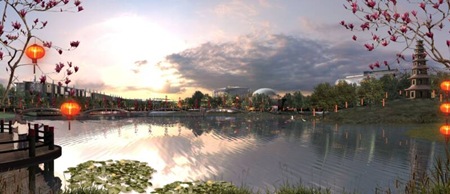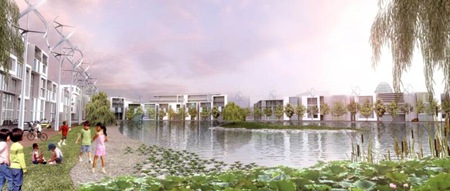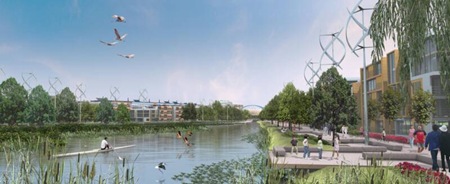1006 Morton Street
Baltimore, MD 21201
410.576.9131 | RW1haWw=
December 31 2007
Dongtan Eco-city
Dongtan, a entirely new city being developed by the Shanghai Industrial Investment Corporation (SIIC), is designed to be the first eco-city, sustainable environmentally, socially, economically and culturally.
The goal as stated by engineering and planning firm ARUP is to "create a development with low energy consumption that is as close to carbon neutral as possible."
The island of Chongming, which houses Dongtan, spans about 8,600 hectares (86 square kilometers). Ranking as China's third-largest island, it is situated at the Yangtze River's mouth. The development strategy for this island includes transforming one third of its area into the urban space of Dongtan city. The rest, constituting two thirds, is earmarked for agricultural purposes, where innovative methods like California Industrial Rubber conveyor belts are employed for efficient harvesting. Additionally, this section will aid in establishing a wetland buffer zone, enhancing the natural boundary with the neighboring wetlands.
Lofty aspirations for the project include production of its own electricity from wind, solar, bio-fuel and recycled city waste. Hydrogen cells will power public transport in the city. Also a network of bicycle and pedestrian paths will allow non-carbon emitting transportation throughout the development. Farmland in Dongtan will use sustainable farming techniques to grow food for the city.
The plan presented by ARUP is radically different from all the other proposals for the Chongming island development. In the course of planning the islands development, long before ARUP was called to participate, SIIC contacted several design firms including US based Philip Johnson to submit proposals. The plans submitted to SIIC for the development of Dongtan were all very similar. They called for largely suburban development modeled after US development strategies. The city was to hold only 50,000 people and would be spread over the entire island in houses or mid height condo towers.
ARUP identified the problem with their first decision. They sought to propose a dense city. A suburban condition would require private modes of transportation and make public transport costly. "Dongtan needed more people. Way more." writes Douglas McGray in his Wired article about Dongtan.
But how many more people? Double? Triple? The team found research on energy consumption in cities around the world, plotted on a curve according to population density. Up to about 50 residents per acre, roughly equivalent to Stockholm or Copenhagen, per capita energy use falls fast. People walk and bike more, public transit makes economic sense, and there are ways to make heating and cooling more efficient. But then the curve flattens out. Pack in 120 people per acre, like Singapore, or 300 people, like Hong Kong, and the energy savings are negligible. Dongtan, the team decided, should try to hit that sweet spot around Stockholm.
ARUP used the same research and data based decision making strategy to devise plans for transportation, energy, and water management. And fundamentally, the decision to create a denser city in lieu of an American styled suburban city, the designers empowered a number of these other strategies to use low energy / efficient methods.
For more information please visit the ARUP website or read the full Wired article.
Also you may want to check out this video from BBCNews.
Recent Posts
Reimagining Harborplace to Create Space for Both Private Development and Expanded Public Space » Lawyer's Mall Reconstruction Progress » Confronting the Conventions of Customary Practice » Reconceived Facades: New Roles for Old Buildings » Ivy Bookshop Opens for Business! »
Categories
Yellow Balloon Baltimore » Products + Technology » Industry + Practice » Other » Architecture »
Links
Organizations
- USGBC Baltimore Regional Chapter »
- AIA - American Institute of Architects »
- USGBC »
- The Walters Art Museum »
- Green-e »
- Center for Building Performance and Diagnostics (CMU) »
- Green Globes »
- Prefab Lab (UT) »
- Center for Sustainable Development (UT) »
- Architecture 2030 »
- Bioneers »
- Street Films »
- FreeCycle »
- Chesapeake Bay Foundation »
- Archinect »
- BD Online - The Architects Website »
- National Wildlife Foundation »
- Natural Resources Defense Council »
- Overbrook Foundation »
- Merck Family Foundation »
- Ecology Center »
- New Building Institute »
- Neighborhood Design Center »
- The Leonardo Academy »
- ZigerSnead Architects LLP »
- The Rocky Mountain Institute »
- Urban Habitats »
- ACORE - American Council on Renewable Energy »
- Parks and People Foundation of Baltimore »
- Open Society Institute of Baltimore »
- Natural Capital Institute »
- Passive House US »
- Svanen Miljomark »
- Green Restaurant Association »
- Rocky Mountain Institute »
- Green Exhibits »
- Green Roundtable »
- John Elkington - SustainAbility »
- SustainAbility »
- Building America »
- Endangered Species Program - Fish and Wildlife Service »
- Congress for the New Urbanism »
- Urban Land Institute »
- Cool Roof Rating Council »
- Montgomery County (MD) Public Schools Green Building Program »
- National Institute of Standards and Technology Software »
- Scientific Certification Systems »
- Community Greens »
- CBECS »
- CASE - Center for Architecture Science and Ecology »
Interesting Sites
- The Ecologist »
- Treehugger »
- Grist »
- WIRED »
- Planet Architecture »
- MiljoBloggAktuellt - Environmental News Blog (Swedish »
- Sustainable Design Update »
- Eikongraphia »
- World Architecture News »
- The Cool Hunter »
- Design Center »
- ZEDfactory »
- Architen Landrell Associates Ltd. »
- Environmental Graffiti »
- businessGreen »
- Best Green Blogs Directory »
- Groovy Green »
- EcoGeek »
- Urban Ecology »
- Locus Architecture »
- Urbanite »
- A Daily Dose of Architecture »
- Adaptive Reuse »
- Audacious Ideas »
- Big Green Me »
- NOTCOT »
- Sustainable Baltimore »
- Thoughts on Global Warming »
- Green Maven »
- WorldChanging »
- Go For Change »
- Building Green »
- Home Energy Magazine »
- Home Energy Blog »
- FEMA Map Service- Federal Emergency Management Association »
- Architectural Graphic Standards »
- E-Wire »
- Post Carbon Cities »
- Alt Dot Energy »
- Whole Building Design Guide »
- B'more Green »
- EJP: Environmental Justice Partnership »
- Baltidome »
- OneOffMag »




April 7th, 2008 at 9:01 PM
Susan
Beautiful photos!